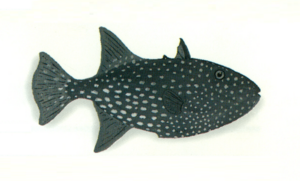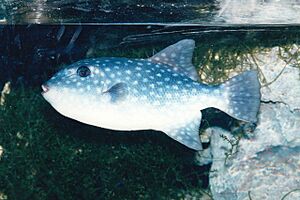Rough triggerfish facts for kids
Quick facts for kids Spotted oceanic triggerfish or Rough triggerfish |
|
|---|---|
 |
|
| Scientific classification |
The Spotted Oceanic Triggerfish, also called the Rough Triggerfish, is a type of triggerfish. You can find it in warm, tropical, and subtropical oceans all over the world. Unlike most triggerfish, these fish usually live in the open ocean, not near the bottom.
In the Philippines, people who speak Cebuano language call it Tikos. It's very common around the Visayas and Mindanao island groups there.
Contents
Where These Fish Live
Spotted Oceanic Triggerfish live in many parts of the world's oceans.
- In the western Pacific Ocean, they are found from the Gulf of Thailand up to the Yellow Sea and Japan. They also live around the Philippines, Indonesia, and all the way to Polynesia and Hawaii.
- In the eastern Pacific Ocean, you can find them from Mexico and the Gulf of California down to Peru and the Galapagos Islands.
- Around the Indian Ocean, they live from the Red Sea and eastern Africa to Seychelles, the Maldives, the Persian Gulf, India, Sri Lanka, the Andaman Sea, Australia, and Indonesia.
- In the Atlantic Ocean, they range from New York down to the Gulf of Mexico, the Bahamas, the Caribbean Sea, and down to Brazil. On the eastern side of the Atlantic, they are found from the British Isles and the Bay of Biscay to the Azores, the Canary Islands, and western Africa. Some also live in South Africa.
These fish prefer warm waters with lots of different kinds of sea life. They like areas with strong currents and places where deep, cool water rises to the surface. You can find them on deep slopes near the shore, in the open ocean, and sometimes under floating objects called Fish Aggregating Devices (FADs). They often gather in huge groups of hundreds or even thousands around FADs.
What They Look Like
Spotted Oceanic Triggerfish can grow up to 50 centimeters (about 20 inches) long. However, they usually measure around 35 centimeters (about 14 inches). Young fish and adult fish look different.
- Adults are a blue-gray color.
- Young fish are grayish-black with white spots. These spots fade as the fish get older.
When adults are mating, they might get dark patches on their faces and fins. Females guarding their nests also show these dark marks. These marks can disappear quickly if the female swims away from her nest.
This fish has two fins on its back called dorsal fins. The first dorsal fin has sharp, spiny rays. The first two rays are like thorns. The smaller second thorn helps hold up the longer first thorn. This makes it look like a "trigger," which is how the fish got its name. Its anal fin, located on its belly, has 20 to 27 rays.
The shape of their tail fin also changes with age. Young fish have rounded tail fins, while adults have tail fins that curve inward.
How They Live (Ecology)
Spotted Oceanic Triggerfish are known to host tiny sea creatures called sea lice. They also visit "cleaning stations" in the ocean. At these stations, smaller fish like the Black-nosed Butterflyfish and Mexican Hogfish clean parasites off them.
What They Eat
These triggerfish are flexible eaters. They can be carnivores (meat-eaters) or planktivores (eating tiny organisms floating in the water). They eat smaller fish, sea skaters (insects that live on the water's surface), and other small sea creatures.
Who Eats Them
Larger ocean predators hunt the Spotted Oceanic Triggerfish. These include big fish like the Indo-Pacific Sailfish and the Dolphinfish (Mahi-mahi). Sea birds, such as Streaked Shearwaters in Japan, also prey on them.
If a mother triggerfish isn't guarding her nest, smaller fish might eat her eggs. These include goatfish, checkerboard wrasse, and even other triggerfish like the Orange-lined Triggerfish and the Titan Triggerfish.
Their Behavior
Spotted Oceanic Triggerfish often gather in very large groups, sometimes hundreds or thousands strong. They are often found near FADs, which are floating objects that attract fish. Other fish species, like the Sleek Unicorn Surgeonfish, might join these groups.
Scientists believe these triggerfish move together as a group. They might migrate from the open ocean to shallower waters to build nests. After nesting, they return to the open ocean together.
These fish are usually shy and not aggressive. They can be easily scared away from their nests by bigger fish or divers. It seems that only female triggerfish guard their nests. Even though they are easily scared by large fish, they will defend their nests from smaller fish that try to eat their eggs.
Why They Matter to People
Spotted Oceanic Triggerfish are somewhat important for commercial fishing. Like other triggerfish, they are sold in local markets in Asian countries to be eaten. Fishermen usually don't target them specifically. Instead, they are often caught by accident when fishing for tuna or using longlines.
These triggerfish are also sometimes sold for aquariums.
There have been reports of people getting sick after eating this fish. This is due to a type of food poisoning called ciguatera.
Fishermen in Kinniya, Sri Lanka, use this species as part of their marine fish production.
Life Cycle and Reproduction
After a female Spotted Oceanic Triggerfish lays her eggs, they take about 33 to 36 hours to hatch. The tiny larvae hatch at night and quickly swim to the surface. This helps them avoid predators. Once at the surface, wind and ocean currents likely carry the larvae into the open ocean. This explains why young fish are spread out unevenly across their habitat. In the open ocean, young fish gather around floating objects like Sargassum seaweed and other debris until they become adults.
Breeding and Nesting
Adult triggerfish find a partner and breed.
Spotted Oceanic Triggerfish seem to nest all year round, and the moon's cycle doesn't appear to affect it. They lay their eggs in sand or broken coral, burying them shallowly. The mother fish then guards and "airs out" the eggs. Many nests are often found close together, suggesting these triggerfish nest in groups. It's not clear how often a female nests each year or if she returns to the same nest. Nests have been found at different depths, from 4 meters (about 13 feet) to over 45 meters (about 148 feet). Deeper nests might be a way to protect them from Titan Triggerfish, which nest in shallower waters and are very protective of their nests.
Conservation Status
The number of Spotted Oceanic Triggerfish around the world is stable. The IUCN (International Union for Conservation of Nature) lists this species as "least concern," meaning they are not currently at risk of disappearing.


